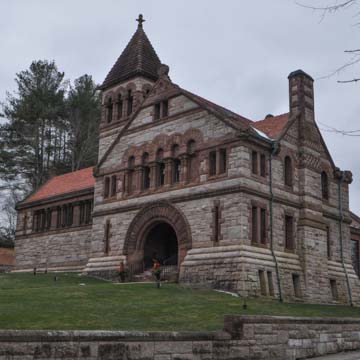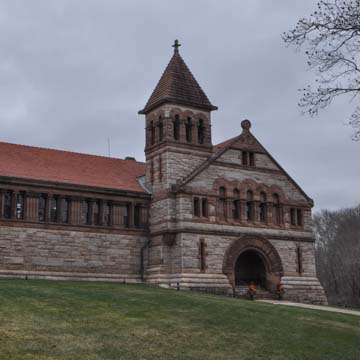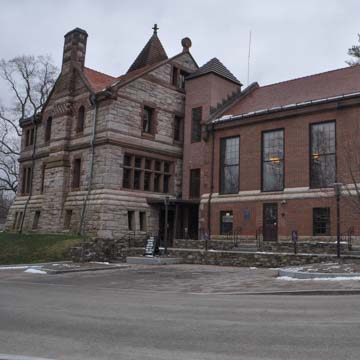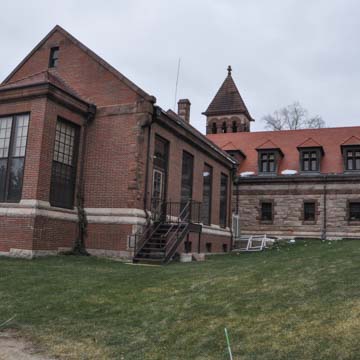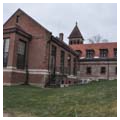While Andrew Carnegie is most often associated with the philanthropist-sponsored construction of public libraries in the nineteenth and twentieth centuries, the practice predated his initiatives. In North Easton, local industrialist Oliver Ames II, whose family had made its fortune in railroads and by supplying digging and trenching equipment (primarily shovels), underwrote a similar, earlier project for the townspeople whose labor had helped him amass his fortune. In 1877, he bequeathed $50,000 in a trust for a “free” library, earmarking $15,000 of that fund as the start of an endowment for the continuous operation of the facility. The library was to be a private institution, held in trust for the public, but not owned by the town as with traditional public libraries. The subsequent Ames Free Library therefore embodies the notion of corporate paternalism prevalent in the late nineteenth and early twentieth centuries.
Ames’s children commissioned local and renowned architect H. H. Richardson for the library’s design in 1877. Richardson was already working on a library in Woburn and would later design a cluster of buildings in Easton. The Ames family also contracted architect Stanford White for the fireplace in the reading room and sculptor Augustus Saint-Gaudens for the decorative medallions of the library’s benefactor. Construction started in 1878 and was completed in 1879, but the library did not open until 1883 possibly because of cost overruns (the final cost of the building and its contents was $80,000).
Essentially rectangular in plan, the Ames Library’s front (north) elevation features three primary elements: a gable-roofed, longitudinal block; a stair tower with a hipped roof; and larger gable entry projection. The main block’s facade features four triforium windows separated by sets of four short columns. Both the tower and gable projections contain in upper levels similar sets of arched windows separated by columns, but the gable’s ground level features the building entry with a low, cavernous arch—Richardson’s first use of this signature element. (Today this entrance has been closed off, supplanted by one accessible from the parking lot, suggesting the library’s shifting clientele.) Smaller, square fenestration topped with granite lintels punctuates the rear elevation and reflects the need for more interior wall space to complement the building’s program. Materially, Richardson utilized a combination of light brown ashlar granite and the same dark reddish brownstone trim he used at Trinity Church in Boston. Except for the steep tower roof’s brown tiles, the roof primarily carries dark orange tiles as an overall accenting color.
The Ames Library’s interior features spaces for patrons and library staff, though its plan deliberately makes the former dependent on the latter. On the ground floor, the entry opens into a hall, which separates the westerly reading room from the easterly stack wing (or book room). The ornate reading room, finished in black walnut paneling with a timbered ceiling, acted as an homage to the benefactor family through its dominant fireplace decorated with medallions containing reliefs of Oliver Ames. Library patrons waited in this room while librarians retrieved volumes from the larger book room on the other side of the hall, with a screen and desk separating the public from the library’s closed-stack section. A two-story, barrel-vaulted space, the stack wing featured window-lit alcoves and a narrow gallery to access the upper story; it is decorated with Colonial Revival motifs. The entry hall also led to the stairway in the tower, which accessed the director’s office above the reading room and the small librarian’s apartment in the third-floor garret.
In 1931, Fanny Holt Ames, a daughter of Oliver, hired Richardson’s successor firm, Shepley, Rutan and Coolidge of Boston, to design a rear children’s wing in red brick. Other than this addition, which eliminated the original lavatory and document room (also accessible from the entry hall), the building has seen several small architectural changes. These include adding shelving in the original stack wing to accommodate a growing collection, elimination of the top-floor librarian’s apartment in the early 1990s, and removal of the now obsolete wooden screen and desk from the book stack wing once patrons were allowed to retrieve volumes themselves.
The Ames library sits on a gently sloping lawn toward Easton’s Main Street. As with Richardson’s other designs, its strongly rusticated and battered foundations make it appear almost to crop up from the lawn, causing the heavy stone building to seem more organic than if situated on a flat site. At the same time, Richardson employed a high foundation at the gable entrance and a level water table wrapping around the building to give the library independence from the terrain and allowing the small building to assert its civic importance. Its location across the street from the main Ames factory buildings reflects its integration with the town’s most important industry and its workforce.
Architectural historians have rightfully stressed the place of the Ames Free Library within Richardson’s career, focusing, in particular, on its use of the same materials as Trinity Church and the first implementation of what would become his signature entryway arch. Yet the building also powerfully speaks to the expression of industrial paternalism beyond the realm of company housing. The extravagant expenditure on this structure and the hiring of renowned designers showcase the Ames family’s desire to provide for the wellbeing of their workers through civic improvements. Its lavishness also exposes their desire to associate the family name with a certain magnanimous attitude that other industrialists like Pullman and Carnegie would come to emulate. An extension of this attitude, long after the decline of industry itself in Easton, may be seen in the family’s underwriting of the children’s wing during the Depression and the hiring of Richardson’s successor firm as a way to extend the family’s legacy. For the next few decades, the Ames family also provided subsequent monetary support for the library’s operation, including a donation as recently as 1998. Not until the 1970s did the town provide support (in part to secure state funding) for a library that continues to be a private institution for the public benefit.
Today the Ames Free Library belongs to a cluster of buildings designed by Richardson and sponsored by the Ames family, which now constitutes a National Historic Landmark District. These include the adjacent Oakes Ames Memorial Hall (1881), nearby Old Colony Railroad Station (1881), Ames Gate Lodge (1881), and F. L. Ames Gardener’s Cottage (1885), along with a Civil War memorial designed by Frederick Law Olmsted called The Rockery (1882). Olmsted also designed the landscapes of several of these buildings. In addition to its situation amidst other Richardson buildings in Easton, the Ames Free Library should be viewed within a landscape of Richardson’s public libraries in Massachusetts. It was predated by the Winn Memorial Library in Woburn (1879) and succeeded by the Thomas Crane Public Library in Quincy (1882) and Converse Memorial Library in Malden (1885).
References
Breisch, Kenneth A. Henry Hobson Richardson and the Small Public Library in America: A Study in Typology. Cambridge: MIT Press, 1997.
Brown, Robert F., “North Easton Historic District,” Bristol County, Massachusetts. National Register of Historic Places Inventory-Nomination Form, 1972. National Park Service, U.S. Department of the Interior, Washington, D.C.
Ochsner, Jeffrey Karl. H. H. Richardson: Complete Architectural Works. Cambridge: MIT Press, 1982.
Pitts, Carolyn, “H. H. Richardson Historic District of North Easton,” Bristol County, Massachusetts. National Register of Historic Places Inventory-Nomination Form, 1987. National Park Service, U.S. Department of the Interior, Washington, D.C.
Upton, Dell. Architecture in the United States. New York: Oxford University Press, 1998.

